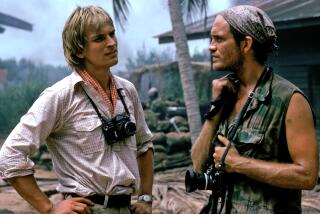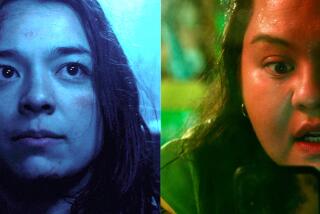LASER BIN : Glimpses Into Digital Sound and Welles’ Career
- Share via
“The Running Man” (Image Entertainment-Vestron, Extended Play CLV, 101 minutes) and “Red Heat” (Image Entertainment-IVE, Extended Play CLV, 106 minutes). $39.95.
These two Arnold Schwarzenegger movies show off the digital sound capabilities of laser video discs as few other films have. You can debate the aesthetic qualities of each film (“The Running Man” is the clear winner here), but there is really only one reason to watch these films: the bone-crunching action that dominates everything else, including Schwarzenegger’s one-liners. The digital stereo surround sound is so clear and lifelike that it puts you in the middle of the action, making the experience even more intense than the one witnessed in a theater. Along with “RoboCop” and “Blade Runner,” these two films make superb demonstration discs that the laser disc is the future of home video.
“Macbeth” (Image Entertainment, Extended Play CLV, 110 minutes) $39.95 and “Touch of Evil” (MCA, Extended Play CLV, 108 minutes).
This is the original, uncut, fully restored version of Orson Welles’ 1946 moody adaptation of “Macbeth” with the characters speaking with Scottish accents. As with many of Welles’ films, “Macbeth” was cut dramatically by distributors and savaged by critics (the commonly shown 89-minute version is the one now available on videotape).
Welles made “Macbeth” to prove a point: that he could produce a film in three weeks, on budget. Republic gave him a chance to take the Shakespeare play from stage to film using papier-mache sets. Welles, upon proving he could do it, left the film uncut and ran off to Europe, destroying all the good will he had created by bringing the film in on time. It was his last Hollywood film for 10 years.
What kind of a film is it? A purposely theatrical film, moody and filled with typical Welles flourishes. The laser digital sound helps clarify the movie’s most controversial aspect--a sound track filled with a mostly unintelligible Scottish burr blurring the Shakespearean text. Obviously not Shakespeare’s “Macbeth,” but fascinating because of Welles’ intensity and vision. Worth looking at in light of Kenneth Branagh’s current “Henry V,” and Welles’ prior version. With Jeannette Nolan, Dan O’Herlihy, Edgar Barrier, Roddy McDowell, Robert Coote, Erskine Sanford, Alan Napier, John Dierkes and several Republican Western extras dressed in appropriate garb.
“Touch of Evil,” the film that brought Welles back to Hollywood, shows the film maker at the height of his powers in an uncut, restored version. The film was taken away from Welles after a first cut and re-edited for “clearer story continuity.”
This original 108-minute version was discovered in 1976 and is justifiably considered one of Welles’ masterpieces--the incredible opening traveling shot is one of the most daring in cinema history and the black-and-white photography by Russell Metty is dazzling. Charlton Heston, who insisted that Welles direct the film, gives one of his best performances, as do Janet Leigh and Joseph Calleia. Marlene Dietrich, Joseph Cotten, Ray Collins and Mercedes McCambridge give enormously effective cameos (all but Dietrich are unbilled performances). Welles, as the corpulent corrupt cop, adds to his gallery of unforgettable characters.
More to Read
Only good movies
Get the Indie Focus newsletter, Mark Olsen's weekly guide to the world of cinema.
You may occasionally receive promotional content from the Los Angeles Times.







